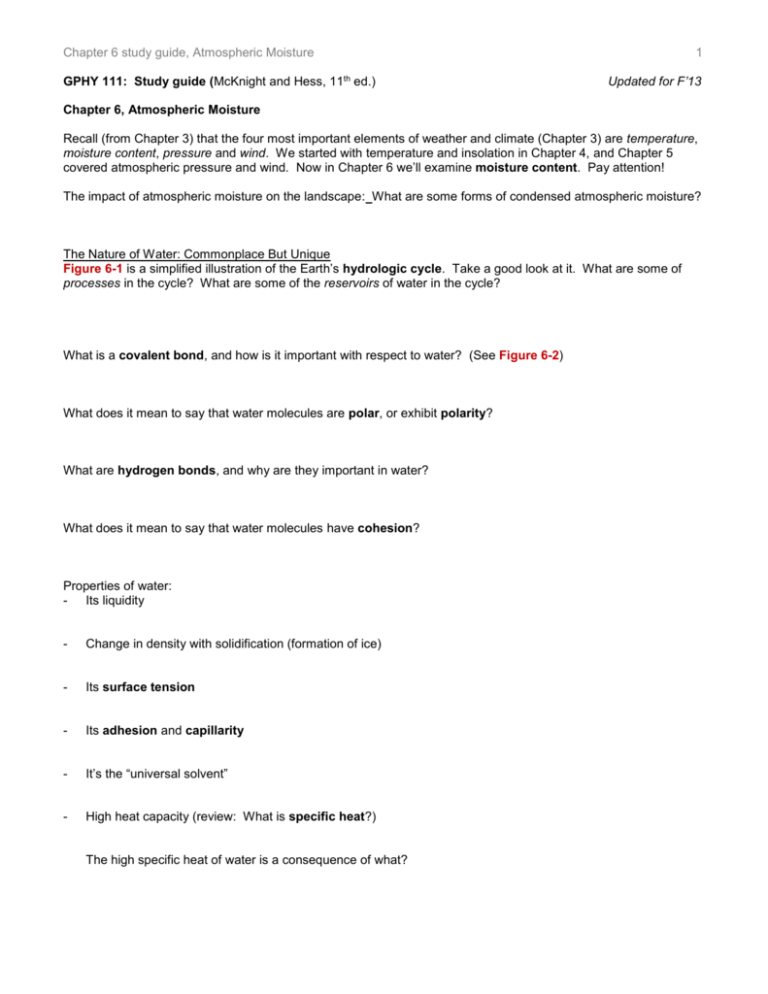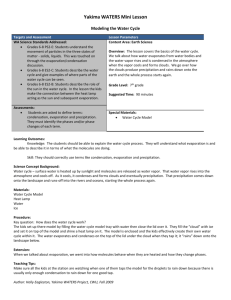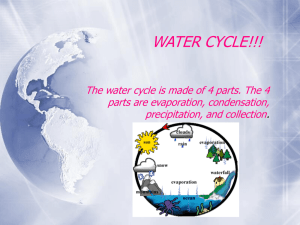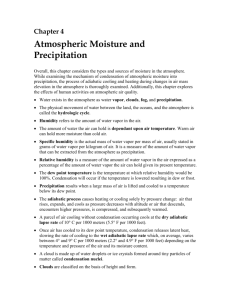Study guide for Chapter 6
advertisement

Chapter 6 study guide, Atmospheric Moisture GPHY 111: Study guide (McKnight and Hess, 11th ed.) 1 Updated for F’13 Chapter 6, Atmospheric Moisture Recall (from Chapter 3) that the four most important elements of weather and climate (Chapter 3) are temperature, moisture content, pressure and wind. We started with temperature and insolation in Chapter 4, and Chapter 5 covered atmospheric pressure and wind. Now in Chapter 6 we’ll examine moisture content. Pay attention! The impact of atmospheric moisture on the landscape: What are some forms of condensed atmospheric moisture? The Nature of Water: Commonplace But Unique Figure 6-1 is a simplified illustration of the Earth’s hydrologic cycle. Take a good look at it. What are some of processes in the cycle? What are some of the reservoirs of water in the cycle? What is a covalent bond, and how is it important with respect to water? (See Figure 6-2) What does it mean to say that water molecules are polar, or exhibit polarity? What are hydrogen bonds, and why are they important in water? What does it mean to say that water molecules have cohesion? Properties of water: - Its liquidity - Change in density with solidification (formation of ice) - Its surface tension - Its adhesion and capillarity - It’s the “universal solvent” - High heat capacity (review: What is specific heat?) The high specific heat of water is a consequence of what? Chapter 6 study guide, Atmospheric Moisture Phase Changes of Water (See Figure 6-4) - Evaporation - Condensation - Sublimation What is latent heat? (See Figures 6-4 and 6-5) What is the latent heat of melting? What is the latent heat of fusion? What is the latent heat of evaporation? What is the latent heat of condensation? Remember: Evaporation is a heating / cooling process, and condensation is a heating / cooling process. Water Vapor and Evaporation What is water vapor? How abundant is water vapor in the atmosphere, and in which layer of the atmosphere is it concentrated? What is evaporation? (See Figure 6-6) Net evaporation occurs when the rate of ____________________________ exceeds the rate of ____________________________. The amount and rate of evaporation from a water surface depends on three factors: 1. Temperature. More evaporation occurs when the air is warmer / cooler. Explain. 2. Water vapor content of air. What is vapor pressure? 2 Chapter 6 study guide, Atmospheric Moisture 3 What does it mean to say air is saturated? When air is saturated, the rate of ____________________________ and the rate of ____________________________ are equal. 3. Wind. When air is moving, expect a higher / lower evaporation rate. Explain. Most water that evaporates into the air comes from bodies of water. What are two sources from land, and which of these is more important? What is transpiration? What is evapotranspiration? What is potential evapotranspiration? How is the potential evapotranspiration of a location determined? (What data are needed?) In most places, the potential evapotranspiration rate is higher / lower than the actual precipitation. What does this mean for groundwater surplus? Measures of Humidity What is humidity? There are several different ways to describe humidity: 1. What is absolute humidity? What are the units it is expressed in? How does absolute humidity vary with air temperature? (See Figure 6-7) 2. What is specific humidity? What are the units it is expressed in? What is the saturation vapor pressure? The most familiar measure of humidity is relative humidity. Give its definition. What are the units used? Chapter 6 study guide, Atmospheric Moisture 4 Relative humidity is a ratio of the actual water vapor content of air to the capacity of the air. What is capacity? Relative humidity changes if either the _________________________________ or the _________________________________ changes, or if the temperature changes. Relative humidity and temperature are inversely / directly (choose one) related (see Figure 6-9). How can air be brought to saturation (and condensation) without adding water vapor to it? What is the dew point or dew point temperature? What is the sensible temperature? It is affected by the air temperature, and also other atmospheric conditions, particularly _________________________________________________ and _______________________. Condensation What is condensation? In order for condensation to take place, the air must be _________________________________. In theory, condensation can be caused by adding water vapor to air, but in practice it is usually the result of what? What is surface tension, and how is it related to supersaturation of air? List some examples of condensation nuclei (or hygroscopic particles) for water vapor in the lower atmosphere. See Figure 6-10. A single raindrop may contain how many condensation nuclei plus associated moisture? What is supercooled water? Adiabatic Processes The only prominent mechanism for the development of clouds and the production of rain is __________________________________________________. Review: What is adiabatic cooling? Chapter 6 study guide, Atmospheric Moisture 5 What is the dry adiabatic lapse rate? (See Figure 6-12) What is the lifting condensation level? (See Figure 6-11) What is the saturated adiabatic lapse rate? (See Figure 6-12) Study Figure 6-13. Remember that adiabatic temperature changes (and the adiabatic lapse rates) accompany air that is moving vertically (rising or descending). The average lapse rate we discussed in Chapter 4 refers to air that is still. Be sure you understand Figures 6-13 and 6-14. (We’ll go over similar figures in class, too.) Clouds What are clouds? How much of the Earth is typically covered by clouds at any time? “Not all clouds _______________________________, but all_______________________________ comes from clouds.” Clouds are classified by their form and altitude. There are three general forms of clouds. (See Table 6.1.) Describe them: - Cirriform clouds - Stratiform clouds - Cumuliform clouds Finally, clouds are also classified on the basis of altitude: (Look over Table 6-1 and Figures 6-15 and 6-16.) - High clouds - Low clouds - Middle clouds - Clouds of vertical development What types of clouds will yield precipitation? What is fog? (See Figure 6-17) Distinguish between the four types of fog (see Figure 6-18) - Radiation fog - Advection fog - Upslope fog (orographic fog) Chapter 6 study guide, Atmospheric Moisture - 6 Evaporation fog How much fog does western Montana get, in days per year? (Use Figure 6-19.) What type of fog is it, generally? What is dew? What is frost? (See Figure 6-20) What kinds of materials may cause “global dimming”? (See the box “People and the environment: Global Dimming.”) Atmospheric Stability Vertical movements of air in the troposphere depend on buoyancy. What is buoyancy? Warm air is more / less buoyant than cool air. What does it mean to say air is stable? (See Figures 6-21 and 6-23) “Highly stable air is normally not associated with ____________________________________________ and ___________________________.” What does it mean to say air is unstable? (See Figures 6-21 and 6-24) Unstable air is typically warmer / cooler than its surroundings, and will rise / descend until it reaches an altitude where the surrounding air has a similar ___________________________ and ___________________________, i.e., until it reaches its equilibrium level. (See Figure 6-24.) What is conditional instability? (See Figure 6-25.) Air is conditionally unstable when its adiabatic lapse rate is somewhere between ___________________________ and ___________________________. Be sure you understand Figure 6-25. The stability of air can be determined visually from the cloud types that are produced. What do cumuliform clouds suggest? Stratiform clouds? Also take a look at Table 6-2; it summarizes this section nicely. Precipitation “All precipitation originates in ______________________, but most do not _______________________________.” Explain why condensation alone is not enough to produce raindrops. Chapter 6 study guide, Atmospheric Moisture How do an average-sized raindrop and average-sized water droplet in a cloud compare, in size? (See Figure 627) Two mechanisms are principally responsible for producing precipitation particles: - Collision and coalescence of water droplets (see Figure 6-27) - Ice-crystal formation (see Figure 6-28)—this is also known as the __________________________ process Describe the following forms of precipitation: rain, snow, sleet, glaze, hail (see also Figures 6-30 and 6-31). Atmospheric Lifting and Precipitation There are four principal causes of atmospheric lifting (rising air; see Figure 6-32): - Convective lifting. Convective lifting occurs due to ___________________________ of different surface areas. Describe convective precipitation. - Orographic lifting What does the term orographic refer to? Describe orographic precipitation. What is a rain shadow? (see Figure 6-33) - Frontal lifting What is a front? Describe frontal precipitation. Where on the globe is frontal activity most and least significant? - Convergent lifting Describe convergent precipitation. Where on the globe is convergent activity most common? Global Distribution of Precipitation (See Figure 6-34) What is an isohyet? What are some of the factors that determine the amount of precipitation on any part of the Earth? 7 Chapter 6 study guide, Atmospheric Moisture 8 Why are the tropical latitudes the wettest on the globe? (Relate the general circulation of the atmosphere to concepts introduced in this chapter.) The other obvious wet zones are the west coasts of North and South America between about 40 and 60 degrees latitude. Explain why. There are three types of dry locations. Explain why there is sparse annual precipitation in these places: - Western sides of continents in the subtropics (around 25 or 30º latitude) - Continental regions in the midlatitudes - High latitudes There are seasonal patterns of precipitation as well. Why are seasonal variations more pronounced over continental interiors that in coastal areas? General seasonal patterns: - Shift of major atmospheric pressure and wind systems - Time of maximum precipitation (See Figure 6-36) - Locations of greatest variation in seasonal precipitation What is precipitation variability? (See Figure 6-37) Where is the highest and lowest precipitation variability found around the globe? (See Figure 6-37) Acid rain What is acid rain? What acids are involved, and what are their sources? What is the pH of “normal” rain, and of “acid” rain? Why is rain usually slightly acidic? (See Figure 6-38) What are some natural buffers (neutralizers) of acid rain? (See also Figure 6-40) What are some of the effects of acid rain? Whew! Be sure to read the Chapter 6 Learning Review on p. 174-175. Can you answer the questions on p. 141?








